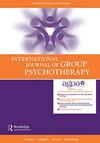理解大规模暴力的群体分析方法:大屠杀、群体幻觉和虚假信仰
IF 1
4区 心理学
Q3 PSYCHOLOGY, CLINICAL
International Journal of Group Psychotherapy
Pub Date : 2021-12-03
DOI:10.1080/00207284.2021.1995287
引用次数: 0
摘要
对大屠杀和大屠杀后心理影响的生动叙述和描述充斥着大量的历史、研究、回忆录和诗歌作品。我很珍惜Garwood(2020)等编年史家对生存和超越的描述,以及对大规模创伤后遗症的阐述,他确定了一个由毁灭性焦虑、无力和失落组成的“创伤原三合一”(第98页)。这些文献帮助我理解了大屠杀对我幸存者的影响——不可磨灭的创伤、愤怒、恐怖、绝望,甚至在庆祝活动中也潜伏着黑暗的阴影。自第二次世界大战以来的几十年里,理论家们一直在努力理解纳粹政权犯下的大规模强迫杀人、大规模流离失所和大规模谋杀。Bennett Roth在其极具洞察力的著作《理解大规模暴力的群体分析方法:大屠杀、群体幻觉和虚假信仰》中强调,这场种族灭绝是在相当大比例的德国民众的积极参与下进行的。罗斯哀叹道,试图了解大屠杀和其他种族灭绝的原因、先决条件和动机的努力充其量只能得到“不充分或部分的解释”。“从群体精神分析的角度来看,一套综合概念或因果过程的明显缺失”促使罗斯对纳粹群体的动态行为进行了深入调查。他试图找出如何以及为什么“一个国家政权参与消灭一部分非亲属人口的代价高昂的活动似乎是合理和必要的”(第84页)。他想知道致命的第三帝国是如何如此有效的国际团体心理治疗杂志,72:102–1052022©2021美国团体心理治疗协会,股份有限公司ISSN:00020-7284打印/1943-2836在线DOI:https://doi.org/10.1080/00207284.2021.1995287本文章由计算机程序翻译,如有差异,请以英文原文为准。
A Group Analytic Approach to Understanding Mass Violence: The Holocaust, Group Hallucinosis and False Beliefs
S urvivor narratives and descriptions of Holocaust and postHolocaust psychic effects fill voluminous works of history, research, memoir, poetry. I’ve treasured accounts of survival and transcendence —and the illumination of sequelae of massive trauma by such chroniclers as Garwood (2020), who identified a “traumatogenic triad” (p. 98) of annihilation anxiety, powerlessness and loss. The literature has helped me understand the Holocaust’s impact on my survivorparents—indelible wounds, rage, terror, despair, dark shadows lurking even during celebratory events. In the decades since World War II, theorists have vigorously attempted to comprehend the incomprehensible—the grand scale of forced killings, mass displacements and mass murders committed by the Nazi regime. A genocide carried out with the active engagement of a shockingly large proportion of the German populace, stresses Bennett Roth in his extraordinarily insightful book A Group Analytic Approach to Understanding Mass Violence: The Holocaust, Group Hallucinosis and False Beliefs. Endeavors to understand causes, preconditions and motives for the Holocaust and other genocides have turned up, at best, “inadequate or partial explanations,” Roth laments. The glaring absence of “a set of integrative concepts or causal processes from a group psychoanalytic perspective” sent Roth on an in-depth investigation of Nazi group dynamic behavior. He sought to find out how and why it could “appear rational and necessary for a state regime to engage in the costly activity of eliminating a portion of their non-kin population” (p. 84). He wanted to know how the deadly Third Reich so effectively International Journal of Group Psychotherapy, 72: 102–105, 2022 © 2021 The American Group Psychotherapy Association, Inc. ISSN: 0020-7284 print/1943-2836 online DOI: https://doi.org/10.1080/00207284.2021.1995287
求助全文
通过发布文献求助,成功后即可免费获取论文全文。
去求助
来源期刊

International Journal of Group Psychotherapy
PSYCHOLOGY, CLINICAL-
CiteScore
2.30
自引率
7.70%
发文量
16
期刊介绍:
Recognized as the leading source of information on group therapy theory, practice, and research, this journal features contributions from foremost experts in the field. International Journal of Group Psychotherapy offers: - Clinical articles on group treatment models, process issues, and techniques - Research reviews that keep practitioners up to date - Thought-provoking essays in the Reader"s Forum and Commentary sections - Reviews of current books and video releases - Special issues on such topics as evidence-based practice and ethics
 求助内容:
求助内容: 应助结果提醒方式:
应助结果提醒方式:


